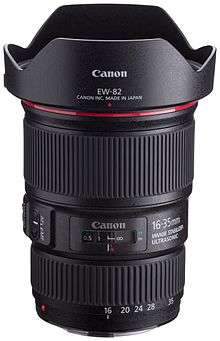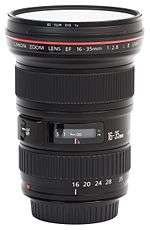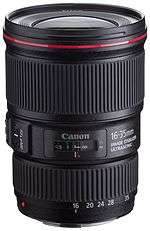Canon EF 16-35mm lens
The EF 16–35 mm lens is a family of professional wide-angle lenses made by Canon Inc. The original version, the EF 16-35mm f/2.8L USM, replaced the EF 17-35mm f/2.8L USM lens, which had itself replaced the EF 20-35mm f/2.8L lens.

The lens has an EF mount to work with the EOS line of cameras. Other than the front element, it is sealed against dust and water, and features a diaphragm which remains nearly circular from f/2.8 to f/5.6.[1]
The EF 16-35mm f/2.8L USM was replaced by the EF 16-35mm f/2.8L II USM early in 2007. The main change saw the lens adopt a new optical design featuring 16 elements in 12 groups.[1] Other changes include a 35 g increase in weight, a larger 82 mm filter diameter and a longer length.[1]
The model II lens has garnered favorable to excellent reviews,[2][3][4][5] and has been used in independent feature films like Marianne which was shot using a Canon EOS 7D.
The next member of the family, the EF 16-35mm f/4L IS USM, was announced in May 2014. While it is one stop slower than the other 16–35 mm versions, it is the first L-series wide-angle zoom to offer image stabilization.[6][7]
Canon announced an upgraded EF 16-35mm f/2.8L III USM in August 2016, with retail availability expected in October of that year.[8] Canon claims that the Mk III version is more durable than the Mk II version, and according to Digital Photography Review, "the Mark III clearly addresses one of its predecessor's largest shortcomings — poor off-center performance".[9]
Specifications
| Attribute | f/2.8L USM | f/2.8L II USM | f/4L IS USM | f/2.8L III USM |
|---|---|---|---|---|
| Image |  |
 |
_(upright).jpg) | |
| Key features | ||||
| Full-frame compatible | ||||
| Image stabilizer | ||||
| Environmental Sealing | ||||
| Ultrasonic Motor | ||||
| L-series | ||||
| Diffractive Optics | ||||
| Technical data | ||||
| Aperture (max–min) | f/2.8–f/22 | f/4–f/22 | f/2.8–f/22 | |
| Construction | 10 groups / 14 elements | 12 groups / 16 elements | 11 groups / 16 elements | |
| # of diaphragm blades | 7 | 9 | ||
| Closest focusing distance | 0.28 m (0.92 ft) | |||
| Max. magnification | 0.22× | 0.23× | 0.25× | |
| Horizontal viewing angle | 98°–54° | |||
| Diagonal viewing angle | 108°10'–63° | |||
| Vertical viewing angle | 74°10'–38° | |||
| Physical data | ||||
| Weight | 600 g (1.3 lb) | 640 g (1.41 lb) | 615 g (1.356 lb) | 790 g (1.74 lb) |
| Maximum diameter | 84 mm (3.3 in) | 89 mm (3.5 in) | 83 mm (3.3 in) | 89 mm (3.5 in) |
| Length | 103 mm (4.1 in) | 112 mm (4.4 in) | 114 mm (4.5 in) | 128 mm (5.0 in) |
| Filter diameter | 77 mm | 82 mm | 77 mm | 82 mm |
| Accessories | ||||
| Lens hood | EW-83E | EW-88 | EW-82 | EW-88D |
| Retail information | ||||
| Release date | September 2001 | April 2007 | May 2014 | August 2016 |
| Currently in production? | ||||
| MSRP US$ | $1,939 (230,000 yen) | $1,599 | $1,099 | $2,199 |
Similar lenses
The EF 16-35mm f/2.8L III USM is Canon's top-end ultra-wide zoom. The f/4 IS USM version is still an L-series lens, but is noticeably less expensive.
- The EF 20-35mm f/2.8L was Canon's first wide angle zoom lens and precedes the 16–35 mm.
- The EF 17-35mm f/2.8L USM replaced the aforementioned 20–35 and was in turn replaced by the original 16–35.
- The EF 17–40mm f/4L is still L-class, but is less expensive than any version of the 16–35. It is one stop slower than the 16–35 f/2.8, and lacks the image stabilization of the 16–35 f/4.
- The EF 20-35mm f/3.5-4.5 USM is consumer-level: significantly lower quality and less expensive.
- The EF-S 10-22mm f/3.5–4.5 USM has an effective angle of view of 16–35 mm due to the 1.6× crop factor. An upper consumer-level lens, it can only be mounted to cameras that support the EF-S format and is slower and less expensive.
- The EF-S 10-18mm f/4.5-5.6 IS STM, announced on the same day as the 16-35mm f/4L IS USM lens, is also exclusive to bodies that support the EF-S format. Intended as a consumer-level lens, it is slower than any other Canon ultrawide zoom, but includes image stabilization and Canon's stepping motor technology. The 10–18 is less than half the price of the 10–22, and a fourth of the price of the 16–35 mm f/4 IS.
References
- http://www.canon.com.hk/en/product/catalog/productItemDetails.do?prrfnbr=100036
- http://www.the-digital-picture.com/reviews/canon-ef-16-35mm-f-2.8-l-ii-usm-lens-review.aspx
- "Archived copy". Archived from the original on 2010-07-24. Retrieved 2011-01-03.CS1 maint: archived copy as title (link)
- http://www.kenrockwell.com/canon/lenses/16-35mm-ii.htm
- http://www.photozone.de/canon_eos_ff/435-canon_1635_28_5d?start=2
- "Canon Broadens Its Imaging Lineup with Two New EF Ultra Wide-Angle Zoom Lenses and White EOS Rebel SL1 Digital SLR Camera" (Press release). Canon U.S.A., Inc. May 13, 2014. Retrieved May 13, 2014.
- "Canon EF 16-35mm f/4 L IS USM Lens Review". Retrieved June 30, 2014.
- "It's Finally Here: Canon U.S.A. Announces The Highly Anticipated EOS 5D Mark IV DSLR Camera And New L-Series Lenses" (Press release). Canon U.S.A., Inc. August 25, 2016. Retrieved August 25, 2016.
- "Canon introduces EF 16-35mm F2.8L III USM and EF 24-105mm F4L IS II USM L-series glass". Digital Photography Review. August 25, 2016. Retrieved August 25, 2016.
External links
| Wikimedia Commons has media related to |